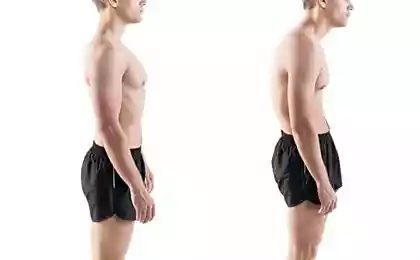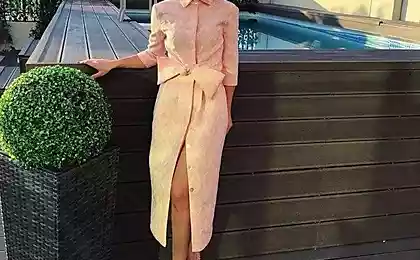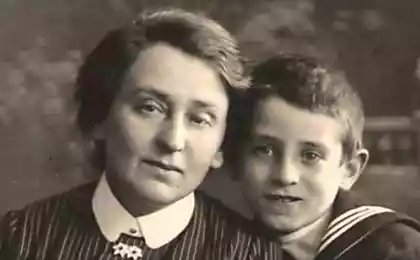882
Show me your posture, and I say that it hurts!
Since childhood, I have heard from my mother these words: "Sit up straight, straighten your back," Then I thought, why did she say that? It seemed to me that my back straight.
Many years later, I began to notice that often sit "crooked," spin - wheel. Sedentary lifestyle, three of pregnancy, and then care with three small children, craze embroidery, and later - sedentary work and the lack of physical activity did not contribute to the development of correct posture
. Then my body started to give signals about the problems: headaches, pain in the shoulder blades, numb and numb hands, cold and numb fingers after a long work with the computer, "backache" in the lower back, etc. We had to change something, and I started to study this topic.
For me was the discovery that health, strength, vigor person does not depend on age, but on the condition of his spine!
Inflexible, fixed, not flexible spine - the source of future disease
The human body is programmed to ensure that in 40 years it has emerged signs of aging and disease, and in 50 years, life was beginning to go to the finish line. Our body is designed so that up to 80-90 years, being physically active, healthy and flexible.
Bernard Macfadyen, who made a great contribution to the development of weightlifting, claimed that anyone can look 30 years younger, strengthening and stretching the spine. The more mobile and flexible spine, the younger man.
Let us look at the animals. For them, the constant training of the spine are everyday movements. Cat throughout the day constantly arches her back. A dog, hugging chest to the ground, pull the front legs. So the animals stretch your spine, allowing them to be energetic until old age.
Would you like to up to 90 years to be physically active and to look 30 years younger? 5 easy steps to help you in this.

Step 1. Check your posture
Option 1. Stand 5 inches from the wall, his back to her, spread your feet hip-width apart. Leans back until it pressed against the wall, and mark what parts of the body you touched it in the first place.
If the first and at the same time reached the walls of the buttocks and shoulders, then you stand correctly. If one side of the body touched the wall before the other, then you do not have a central equilibrium. If the first were the buttocks, then you favor the pelvis. If the first were his shoulders, then you are too tense back and pelvis forward too pronounced. If you touched the first spin, you slouch.
Option 2: Take a photo in a profile in full growth. In the photo a vertical line - ear, shoulder, hip, knee. The line should be straight.
The most frequent errors in posture.
Head tilted forward.
Shoulders tense and rounded.
The blades stick out like wings.
Sunken chest, his back bent.
The pelvis is shifted forward or backward, left or right.
His head tilted to the side.
Shoulders at different levels.
Weight falls on one leg and foot.
Step 2: Learn how to properly stand
The most important exercise for good posture.
Stand with your back to the wall. Legs slightly arrange the hands lower. Keep the neck, shoulders, calves and heels touching the wall.
Pick stomach. Neck a little pull up. The knees bend slightly, shoulders straighten, but do not lift.
Try to understand and remember, what sensations have arisen in your body. Pay special attention to the muscles of the back and abdomen.
The more often you will perform this exercise, the better. First, learn how to hold a position of the body against the wall for a minute without discomfort. Then take a step forward from the wall and stand in this position. Remember your feelings in the body.
Many years later, I began to notice that often sit "crooked," spin - wheel. Sedentary lifestyle, three of pregnancy, and then care with three small children, craze embroidery, and later - sedentary work and the lack of physical activity did not contribute to the development of correct posture
. Then my body started to give signals about the problems: headaches, pain in the shoulder blades, numb and numb hands, cold and numb fingers after a long work with the computer, "backache" in the lower back, etc. We had to change something, and I started to study this topic.
For me was the discovery that health, strength, vigor person does not depend on age, but on the condition of his spine!
Inflexible, fixed, not flexible spine - the source of future disease
The human body is programmed to ensure that in 40 years it has emerged signs of aging and disease, and in 50 years, life was beginning to go to the finish line. Our body is designed so that up to 80-90 years, being physically active, healthy and flexible.
Bernard Macfadyen, who made a great contribution to the development of weightlifting, claimed that anyone can look 30 years younger, strengthening and stretching the spine. The more mobile and flexible spine, the younger man.
Let us look at the animals. For them, the constant training of the spine are everyday movements. Cat throughout the day constantly arches her back. A dog, hugging chest to the ground, pull the front legs. So the animals stretch your spine, allowing them to be energetic until old age.
Would you like to up to 90 years to be physically active and to look 30 years younger? 5 easy steps to help you in this.

Step 1. Check your posture
Option 1. Stand 5 inches from the wall, his back to her, spread your feet hip-width apart. Leans back until it pressed against the wall, and mark what parts of the body you touched it in the first place.
If the first and at the same time reached the walls of the buttocks and shoulders, then you stand correctly. If one side of the body touched the wall before the other, then you do not have a central equilibrium. If the first were the buttocks, then you favor the pelvis. If the first were his shoulders, then you are too tense back and pelvis forward too pronounced. If you touched the first spin, you slouch.
Option 2: Take a photo in a profile in full growth. In the photo a vertical line - ear, shoulder, hip, knee. The line should be straight.
The most frequent errors in posture.
Head tilted forward.
Shoulders tense and rounded.
The blades stick out like wings.
Sunken chest, his back bent.
The pelvis is shifted forward or backward, left or right.
His head tilted to the side.
Shoulders at different levels.
Weight falls on one leg and foot.
Step 2: Learn how to properly stand
The most important exercise for good posture.
Stand with your back to the wall. Legs slightly arrange the hands lower. Keep the neck, shoulders, calves and heels touching the wall.
Pick stomach. Neck a little pull up. The knees bend slightly, shoulders straighten, but do not lift.
Try to understand and remember, what sensations have arisen in your body. Pay special attention to the muscles of the back and abdomen.
The more often you will perform this exercise, the better. First, learn how to hold a position of the body against the wall for a minute without discomfort. Then take a step forward from the wall and stand in this position. Remember your feelings in the body.
























